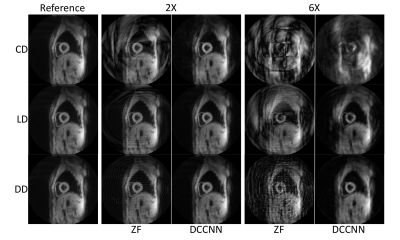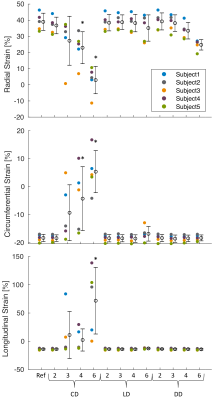Samuel Fielden1,2, Eric Carruth1, Brandon Fornwalt1,3,4, and Christopher Haggerty1,3
1Translational Data Science and Informatics, Geisinger, Danville, PA, United States, 2Medical and Health Physics, Geisinger, Danville, PA, United States, 3Heart Institute, Geisinger, Danville, PA, United States, 4Radiology, Geisinger, Danville, PA, United States
1Translational Data Science and Informatics, Geisinger, Danville, PA, United States, 2Medical and Health Physics, Geisinger, Danville, PA, United States, 3Heart Institute, Geisinger, Danville, PA, United States, 4Radiology, Geisinger, Danville, PA, United States
The performance of deep learning-based reconstructions for accelerated DENSE imaging via k-space undersampling is dependent upon the acquisition trajectory.

Figure 2. Peak systolic magnitude image from one subject, reconstructed with zero filling (ZF) and the DCCNN for all trajectories and acceleration rates 2X and 6X (3X and 4X omitted for space).

Figure 4. Global radial (top), circumferential (middle), and longitudinal (bottom) strains derived from images reconstructed from each of the three trajectories across all acceleration rates. Statistically significant differences (*p<0.05) from the fully-sampled reference were found for high acceleration rates when employing the CD trajectory.
